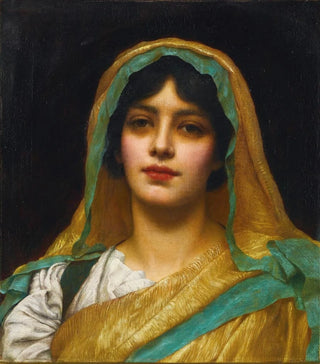Art print | Head of a Girl, Atalanta - John William Godward


View from behind

Frame (optional)
Art print Tête d'une fille, Atalante, by John William Godward – Captivating Introduction
The art print "Tête d'une fille, Atalante" by John William Godward embodies a timeless delicacy and beauty that immediately captivates the viewer. In this piece, the British artist transports us to a world where classical aesthetics meet modern sensibility. Godward, often associated with the neoclassical movement, manages to evoke both grace and melancholy through the portrait of Atalante, a mythological figure rich in symbolism. The work is an ode to feminine beauty, while also revealing the emotional complexities surrounding it. Through this artwork, the viewer is invited to explore the nuances of the human soul, all while admiring the artist's technical mastery.
Style and uniqueness of the work
Godward's style is distinguished by his ability to blend elements of Antiquity with Victorian sensibility. In "Tête d'une fille, Atalante," the color palette chosen by the artist evokes an atmosphere of serenity and dreaminess. Soft hues and subtle contrasts create an airy, almost ethereal ambiance. The depiction of Atalante's face, with its delicate features and contemplative gaze, demonstrates meticulous attention to detail. Godward excels in rendering textures, whether in the softness of the hair or the luminosity of the skin. Every element of the composition contributes to a visual harmony that transcends a simple portrait, becoming a true exploration of beauty and emotion.
The artist and his influence
John William Godward, born in 1861, is often regarded as one of the last representatives of neoclassicism. His career spanned a period when academic art was in decline, and he managed to forge a unique identity within a changing artistic landscape. Influenced by masters such as Sir Lawrence Alma-Tadema and the great classical painters, Godward developed a style that is his own, combining impeccable technique with romantic sensitivity. His work is marked by a constant pursuit of ideal beauty, often inspired by mythology and history. Through his paintings, he manages

Matte finish

View from behind

Frame (optional)
Art print Tête d'une fille, Atalante, by John William Godward – Captivating Introduction
The art print "Tête d'une fille, Atalante" by John William Godward embodies a timeless delicacy and beauty that immediately captivates the viewer. In this piece, the British artist transports us to a world where classical aesthetics meet modern sensibility. Godward, often associated with the neoclassical movement, manages to evoke both grace and melancholy through the portrait of Atalante, a mythological figure rich in symbolism. The work is an ode to feminine beauty, while also revealing the emotional complexities surrounding it. Through this artwork, the viewer is invited to explore the nuances of the human soul, all while admiring the artist's technical mastery.
Style and uniqueness of the work
Godward's style is distinguished by his ability to blend elements of Antiquity with Victorian sensibility. In "Tête d'une fille, Atalante," the color palette chosen by the artist evokes an atmosphere of serenity and dreaminess. Soft hues and subtle contrasts create an airy, almost ethereal ambiance. The depiction of Atalante's face, with its delicate features and contemplative gaze, demonstrates meticulous attention to detail. Godward excels in rendering textures, whether in the softness of the hair or the luminosity of the skin. Every element of the composition contributes to a visual harmony that transcends a simple portrait, becoming a true exploration of beauty and emotion.
The artist and his influence
John William Godward, born in 1861, is often regarded as one of the last representatives of neoclassicism. His career spanned a period when academic art was in decline, and he managed to forge a unique identity within a changing artistic landscape. Influenced by masters such as Sir Lawrence Alma-Tadema and the great classical painters, Godward developed a style that is his own, combining impeccable technique with romantic sensitivity. His work is marked by a constant pursuit of ideal beauty, often inspired by mythology and history. Through his paintings, he manages






